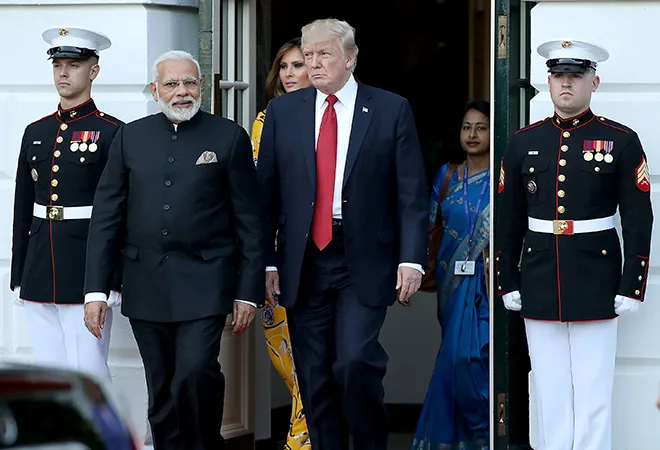It is an irony of sorts that despite the effort made by the Modi government in its first term to keep on the right side of the erratic Donald Trump, President of the United States, the going with our strategic partner is getting tougher.
The US has withdrawn the preferential trading treatment accorded to India just a month after New Delhi quietly stopped trading oil with Iran in the wake of an American demarche. Now, another humiliation stares us in the face as Uncle Sam pushes us to abandon our deal with the Russians for the supply of S-400 missile systems.
The official spokesman, Raveesh Kumar, told journalists last week that he was not ready to share any information as to how India would deal with the demand. All he was willing to say was ‘you know we already have a contract which had been signed and you already know that the steps are being taken to implement the contract’. In essence, what the US is saying is that if India wants a strategic partnership, it must accept the primacy of US interests over its own.
The options for India are not easy. Having been the beneficiary of what Ashley Tellis says is ‘extraordinary US generosity’ in the past decade plus, New Delhi still finds it difficult to accept the US lead on its policies towards Iran, Russia, or the Indo-Pacific. Put it down to its non-aligned history, or lassitude, India does not seem to know, the Americans believe, what is in its national interests.
What the US is saying is that if India wants a strategic partnership, it must accept the primacy of US interests over its own.
Trump’s policies are, of course, not uniquely directed at India. They stem from a deep belief that countries have used the US for their own ends without reciprocating. The reality is different. The US led a globalisation process that has given it enormous wealth and power which cannot be counted just in the value of goods or services traded. Just how much power is evident from the American ability to bring China’s technology powerhouses to their knees or leave Europe fumbling for a response in the wake of the US trashing the Joint Comprehensive Plan of Action (JCPOA) on Iran.
The American readiness to walk out of this pact, or threaten Mexico with tariffs on an issue that had nothing to do with trade, points to the fact that the country that led the concept of a rules-based international order now insists on whimsically rewriting the rules whenever it suits it. Worse, it does not care whether its approach hurts friends, allies or adversaries.
American brinksmanship runs the risk of creating even more problems. Again, not specifically aimed at India, but where we could be collateral casualties. The first is instability and conflict in a zone vital for our external interests—the Persian Gulf region, the largest source of oil and foreign exchange for the country.
If the US needs India to balance China in the Asia Pacific region, New Delhi needs Washington to counter the Chinese rise in the South Asian and Indian Ocean Region.
At the bottom of a lot of these issues is the emerging US-China Cold War. Washington has launched what it says is a long overdue counteroffensive against Beijing. But instead of gathering its allies and coordinating its policies with them, the US has decided what the strategy and tactics are and expects them to merely follow its lead. This is most evident in its dealings with Europe. Even while holding out the threat of car and auto parts tariffs on Europe on specious ‘national security’ grounds, Washington wants the Europeans to respond as aggressively towards China as it has done.
The European response has been nuanced. They have tightened up their procedures on technology transfer, even while continuing to invest heavily in China. There was significant European presence at the 2nd Belt and Road Forum held in Beijing earlier this year and European companies are keen to meet the BRI more than half-way if the Chinese offer a more level playing field. Actually, the US-China spat has given Europe a useful handle to obtain one.
Where does India figure in this emerging world where the rule-maker has turned rule-breaker? India has in the past suffered from the US use of sanctions in pursuit of its policy goals. But things have changed. If the US needs India to balance China in the Asia Pacific region, New Delhi needs Washington to counter the Chinese rise in the South Asian and Indian Ocean Region. This reality has led to a generally smooth course in Indo-US relations through Modi’s first term. But the more recent developments are generating concern.
The US-led world order was a reasonably comfortable place for India till now. From its position at the top of the system, adopting a liberal approach, Washington offered large swathes of autonomy for secondary states like India. It may not always have been comfortable with our strategic autonomy, but it was not overly bothered about it either. Especially since New Delhi did broadly accept the US leadership of the global system, not challenging it on anything that it considered vital. America was the leader, but did not insist beyond a point that you had to follow.
Things have been changing under Trump. Perhaps it is the ‘civilisational’ challenge from a non-Caucasian power, or something else, but China seems to have convinced the US that it can only be fought off by the US openly, and somewhat crudely, exercising its dominance of the international system.
This commentary originally appeared in The Tribune.
The views expressed above belong to the author(s). ORF research and analyses now available on Telegram! Click here to access our curated content — blogs, longforms and interviews.




 PREV
PREV


